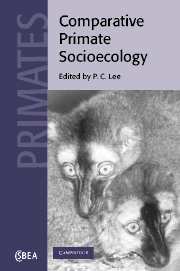Book contents
- Frontmatter
- Contents
- List of contributors
- Preface
- Part 1 Comparative methods
- Part 2 Comparative life history and biology
- 4 Socioecology and the evolution of primate reproductive rates
- 5 Comparative ecology of postnatal growth and weaning among haplorhine primates
- 6 Some current ideas about the evolution of the human life history
- 7 The evolutionary ecology of the primate brain
- 8 Sex and social evolution in primates
- 9 Mating systems, intrasexual competition and sexual dimorphism in primates
- Part 3 Comparative socioecology and social evolution
- Editor's conclusion: Socioecology and social evolution
- Index
7 - The evolutionary ecology of the primate brain
Published online by Cambridge University Press: 24 August 2009
- Frontmatter
- Contents
- List of contributors
- Preface
- Part 1 Comparative methods
- Part 2 Comparative life history and biology
- 4 Socioecology and the evolution of primate reproductive rates
- 5 Comparative ecology of postnatal growth and weaning among haplorhine primates
- 6 Some current ideas about the evolution of the human life history
- 7 The evolutionary ecology of the primate brain
- 8 Sex and social evolution in primates
- 9 Mating systems, intrasexual competition and sexual dimorphism in primates
- Part 3 Comparative socioecology and social evolution
- Editor's conclusion: Socioecology and social evolution
- Index
Summary
Introduction
Comparative studies of the brain have long intrigued and frustrated researchers. They have intrigued because of what they might reveal about the evolutionary forces shaping cognitive attributes. They have frustrated because the results have been so difficult to interpret, leading to a raft of further questions. What is the cognitive significance of differences in brain size? Do correlations between brain size and ecology indicate selection pressures on specific-information processing abilities, or merely some kind of general constraints on brain size? The ratio of speculation to hypothesis testing in this area has been so far above unity as to question its scientific credibility. Yet there are hypotheses to be tested. Is variation in brain size associated with the differential expansion of specific neural systems? If so, does the differential expansion of such systems correlate with relevant behavioural or ecological variables? Or is brain size simply determined by biological constraints, like metabolic rate? Tests of predictions arising from such questions are described in this chapter, based on the data in Appendices 7.1 and 7.2. Some of the methodological principles and problems associated with these tests are emphasised, starting with a discussion (parallel to Purvis and Webster's, Chapter 3) of the importance of controlling for phylogeny when testing for correlated evolution among brain traits and other variables.
Phylogeny and brain evolution
The comparative method can be used to test hypotheses about adaptation. Indeed, ‘adaptation is an inherently comparative idea’ (Harvey and Pagel, 1991: p. 13). Purvis and Webster (Chapter 3) explain why comparative studies must take phylogeny into account when testing for correlated evolution between biological, behavioural and ecological traits (Harvey and Pagel, 1991).
- Type
- Chapter
- Information
- Comparative Primate Socioecology , pp. 167 - 203Publisher: Cambridge University PressPrint publication year: 1999
- 50
- Cited by



